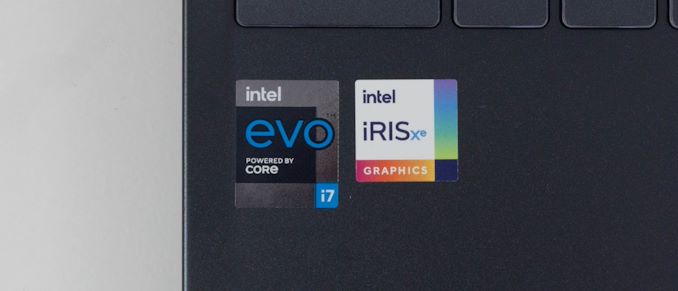Intel Confirms Tiger Lake-U Refresh Later in 2021
by Dr. Ian Cutress on April 27, 2021 10:00 AM EST- Posted in
- CPUs
- Intel
- Notebooks
- Tiger Lake
- Xe-LP
- Willow Cove
- 11th Gen
- Tiger Lake-U

The combination of Intel’s ability to drive 10nm product onto the shelves coupled with silicon supply chain shortages has put into question exactly what might be coming into the market later this year on the client side of the business. A few weeks ago Intel stated that across the company five CPU platforms would be coming to market in 2021: Rocket Lake, Jasper Lake, Ice Lake Xeon, Alder Lake, and the Tiger Lake-H series of processors. Tiger Lake-H at 45W+ will come to market in Q2, however AnandTech has learned and confirmed that later in 2021 Intel will also be launching a refresh of its notebook 15-28W Tiger Lake-U processors as well, called TGL-R.
The original Tiger Lake-U family was launched in September 2020 using Intel’s 10nm SuperFin manufacturing process. The silicon design used four of Intel’s latest Willow Cove processor cores, with the top 28 W model offering a turbo frequency up to 4.8 GHz and a base frequency of 3.0 GHz. Tiger Lake also enables 96 execution units of the new Xe-LP graphics technology, up to 1350 MHz, with support for DDR4-3200 and LPDDR4X-4266.
Technically Intel stated that Tiger Lake-U also supported LPDDR5-5400 when the product was launched, however we have not seen a Tiger Lake-U design with this feature. A Tiger Lake-Refresh might have this key feature enabled with a new family of processors, alongside minor frequency increases as Intel is able to optimize its 10nm SuperFin manufacturing process.
During Intel’s presentation where TGL-U refresh was mentioned, it was specified that the refresh will only apply for 15-28 W processors. Earlier this year Intel launched TGL-H35, which is a misleading name as it uses the U-series processors but brings them up to 35 W (the name suggests a 45W H-series processor reduced in power, but it isn’t). Going on what was presented, these 35W versions of the U-series silicon will not get an equivalent refresh, at least based on this slide talking specifically about 2021.
There are two ways to think about Intel launching TGL-R.
First is that Intel has already announced that its next-generation Alder Lake processors, using a Core + Atom hybrid design, will be coming out later this year for mobile and desktop. That platform would seem to benefit heavily from having the high-efficiency Atom cores in notebook designs more than a TGL refresh. It would seem odd for Intel to offer a Tiger Lake-U refresh if Alder Lake was close to being ready; and so one might conclude that the mobile versions of Alder Lake are more of a late Q4 discussion.
The second is the LPDDR5 angle, assuming that is working. Intel may now have validated the silicon for LPDDR5-5600 which might not have been possible when TGL-U was launched, or LPDDR5 availability may now be at a level that Intel’s OEM partners can deploy it at a reasonable cost. A fully populated LPDDR5-5600 mobile processor would enable a peak memory bandwidth of 89.6 GB/s, which is 75% above DDR4-3200 or 31% above LPDDR4X-4267. For graphics workloads, this would surely boost performance.
If Intel doesn't have LPDDR5 systems with TGL-R, then we fully expect the new line of processors to solely have frequency updates.
Related Reading
- Intel’s Tiger Lake 11th Gen Core i7-1185G7 Review and Deep Dive: Baskin’ for the Exotic
- Insights into DDR5 Sub-timings and Latencies
- Intel Announces Phantom Canyon: Tiger Lake and Turing Tango in 3rd Gen Enthusiast NUC
- Intel at CES 2021: Ice, Tiger, Rocket, Jasper, and Alder Lake
- Intel’s New H35 Series: Quad Core Tiger Lake now at 35 W for 5.0 GHz
- The MSI Prestige 14 Evo Review: Testing The Waters Of Tiger Lake
- Intel’s New NUC Laptop Kit: Whitebook Tiger Lake For All
- GIGABYTE Unveils BRIX PRO Mini-PCs with Tiger Lake-U











36 Comments
View All Comments
Spunjji - Wednesday, April 28, 2021 - link
Yeah, I have to agree that seeing a TL refresh gives me the impression that Intel are either going to be later with AL than planned, or - more likely - *later with volume* than planned.Rocket Lake's volume launch was already giving me that impression before, albeit to a lesser extent.
drothgery - Wednesday, April 28, 2021 - link
Intel had already announced they were going to launch Adler Lake on the desktop first.Arsenica - Tuesday, April 27, 2021 - link
The slide puts Tiger Lake R in the thin and light segment and Alder lake in the nebulous "mobile" segment which hints that Alder lake's performance in thin and light may not be as good as expected.The thin and light <15W Alder lake SKUs are supposed to have up to 2 Golden Cove cores and 8 Gracemont cores so it may be possible that Tiger lake R's 4 Sunny cove cores provide better performance in this segment.
For the thin and light 15-28W segment Alder lake will have 4-6 Golden cove cores so if they are also positioning Tiger lake R in this segment then delays or yields may be the issue.
Rudde - Tuesday, April 27, 2021 - link
Nit-pick, Tiger Lake has Willow Cove cores. Alder lake starting with the ultralow power segment would make sense in regard to both yields and heat, both of which are uncertain with 10ESF and Foveros. I'm sure Alder Lake will stay below 4 Golden Cove cores for the mobile market. 2 Golden Cove and 8 Gracemont cores should have both better single- and multithreaded performance at similar area to 4 Golden Cove cores.Another possibility is that OEMs want a safe option, fearing that the new Alder Lake design will be unstable or hard to market. Laptops with active cooling will need to have their CPU cooling redesigned, which introduces risks.
lmcd - Tuesday, April 27, 2021 - link
Yea the prior poster probably got confused from everyone talking about Sunny Cove/Cypress Cove for Rocket Lake.I don't know if I'd call it a nitpick -- Willow Cove had a pretty big performance jump.
My speculation with Alder Lake is that it isn't as small as Tiger Lake and won't fit in existing designs. Also, I'm assuming Intel once again is producing at most 2-3 distinct dies for consumer products, and the lowest-sized die might be bigger than Tiger Lake.
repoman27 - Tuesday, April 27, 2021 - link
Alder Lake is a hybrid core design but doesn’t use Foveros, at least not that I’m aware of. There are 2 LP dies (2+8+2 and 6+8+2) and 2 HP dies (6+0+1 and 8+8+1) along with 4 packages (M,P,S-BGA, and S). TGL-UR will supplement the ADL-U15 and ADL-U28 platforms, which are the 2+8+2 LP and 6+8+2 LP dies respectively along with the ADP-LP PCH in the P package (BGA 1744, 50 mm x 25 mm).In order for Intel to maintain their typical annual launch cadence (U/Y press embargo in August) they would need to hit PRQ and begin volume production of those dies within the next few weeks. Either they know that is unlikely, or this was the plan all along. I’m guessing this is just the necessary continuation of their split process / split architecture strategy, except with ADL on 10ESF and TGL-R on 10SF replacing TGL on 10SF and CML on 14++.
Not sure why Ian went from LPDDR5-5400 to LPDDR5-5600 at the end of the article. I wasn’t expecting anything more than LPDDR5-5400 out of TGL or ADL.
Spunjji - Wednesday, April 28, 2021 - link
Seconding that lack of Foveros - it wouldn't make any sense in that market segment, and there's no indication that Intel have figured out how to get power levels above ~7W with a stacked die.Thanks for the clarity on the die designs and such, that was a lot of info!
Spunjji - Wednesday, April 28, 2021 - link
Also, your comment on split process/architecture makes sense, and ties into the possibility that they're still either capacity or yield constrained on the various 10nm processes.Spunjji - Wednesday, April 28, 2021 - link
I'd expect to see trade-offs between Alder Lake and Tiger at the 15W level depending on whether the focus is on MT performance, peak ST, or mixed workloads. In theory AL should have more sustainable performance at restricted power levels, but it probably won't look as good for mixed workloads where the cooling system can cope with ~30W thermal load.Hulk - Tuesday, April 27, 2021 - link
Faster memory and increased frequency in the same TDP are always welcome. It'll be interesting to see what actually comes to fruition with this refresh.